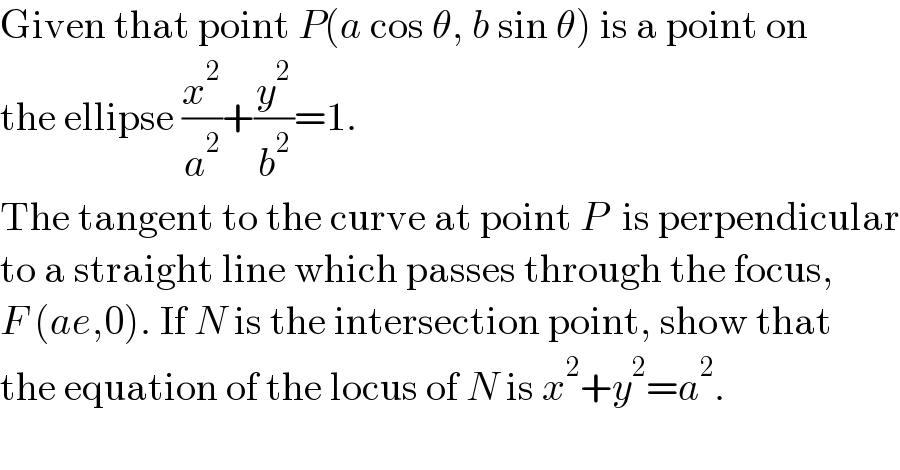
Question Number 157867 by ZiYangLee last updated on 29/Oct/21

$$\mathrm{Given}\:\mathrm{that}\:\mathrm{point}\:{P}\left({a}\:\mathrm{cos}\:\theta,\:{b}\:\mathrm{sin}\:\theta\right)\:\mathrm{is}\:\mathrm{a}\:\mathrm{point}\:\mathrm{on} \\ $$$$\mathrm{the}\:\mathrm{ellipse}\:\frac{{x}^{\mathrm{2}} }{{a}^{\mathrm{2}} }+\frac{{y}^{\mathrm{2}} }{{b}^{\mathrm{2}} }=\mathrm{1}. \\ $$$$\mathrm{The}\:\mathrm{tangent}\:\mathrm{to}\:\mathrm{the}\:\mathrm{curve}\:\mathrm{at}\:\mathrm{point}\:{P}\:\:\mathrm{is}\:\mathrm{perpendicular} \\ $$$$\mathrm{to}\:\mathrm{a}\:\mathrm{straight}\:\mathrm{line}\:\mathrm{which}\:\mathrm{passes}\:\mathrm{through}\:\mathrm{the}\:\mathrm{focus}, \\ $$$${F}\:\left({ae},\mathrm{0}\right).\:\mathrm{If}\:{N}\:\mathrm{is}\:\mathrm{the}\:\mathrm{intersection}\:\mathrm{point},\:\mathrm{show}\:\mathrm{that} \\ $$$$\mathrm{the}\:\mathrm{equation}\:\mathrm{of}\:\mathrm{the}\:\mathrm{locus}\:\mathrm{of}\:{N}\:\mathrm{is}\:{x}^{\mathrm{2}} +{y}^{\mathrm{2}} ={a}^{\mathrm{2}} . \\ $$
Answered by mr W last updated on 30/Oct/21
=0 ⇒u^2 +v^2 −a^2 =0 i.e. the locus of point N is x^2 +y^2 −a^2 =0 or x^2 +y^2 =a^2 ^(∗)) see Q157926](Q157877.png)
$${c}={ae}=\sqrt{{a}^{\mathrm{2}} −{b}^{\mathrm{2}} } \\ $$$${say}\:{point}\:{N}\left({u},{v}\right) \\ $$$${eqn}.\:{of}\:{PN}\:{is} \\ $$$${y}={v}−\frac{{u}−{c}}{{v}}\left({x}−{u}\right) \\ $$$$\Rightarrow\left({u}−{c}\right){x}+{vy}={u}^{\mathrm{2}} +{v}^{\mathrm{2}} −{uc} \\ $$$${since}\:{PN}\:{is}\:{tangent}\:{to}\:{ellipse}, \\ $$$${a}^{\mathrm{2}} \left({u}−{c}\right)^{\mathrm{2}} +{b}^{\mathrm{2}} {v}^{\mathrm{2}} =\left({u}^{\mathrm{2}} +{v}^{\mathrm{2}} −{uc}\right)^{\mathrm{2}} \:\:\:\:\:\:\:\:^{\left.\ast\right)} \\ $$$$\left({u}^{\mathrm{2}} +{v}^{\mathrm{2}} +{a}^{\mathrm{2}} −{b}^{\mathrm{2}} −\mathrm{2}{uc}\right)\left({u}^{\mathrm{2}} +{v}^{\mathrm{2}} −{a}^{\mathrm{2}} \right)=\mathrm{0} \\ $$$$\left({u}^{\mathrm{2}} +{v}^{\mathrm{2}} +{c}^{\mathrm{2}} −\mathrm{2}{uc}\right)\left({u}^{\mathrm{2}} +{v}^{\mathrm{2}} −{a}^{\mathrm{2}} \right)=\mathrm{0} \\ $$$$\left[\left({u}−{c}\right)^{\mathrm{2}} +{v}^{\mathrm{2}} \right]\left({u}^{\mathrm{2}} +{v}^{\mathrm{2}} −{a}^{\mathrm{2}} \right)=\mathrm{0} \\ $$$$\Rightarrow{u}^{\mathrm{2}} +{v}^{\mathrm{2}} −{a}^{\mathrm{2}} =\mathrm{0} \\ $$$${i}.{e}.\:{the}\:{locus}\:{of}\:{point}\:{N}\:{is} \\ $$$${x}^{\mathrm{2}} +{y}^{\mathrm{2}} −{a}^{\mathrm{2}} =\mathrm{0} \\ $$$${or} \\ $$$${x}^{\mathrm{2}} +{y}^{\mathrm{2}} ={a}^{\mathrm{2}} \\ $$$$ \\ $$$$\:^{\left.\ast\right)} \:{see}\:{Q}\mathrm{157926} \\ $$
Commented by mr W last updated on 29/Oct/21

